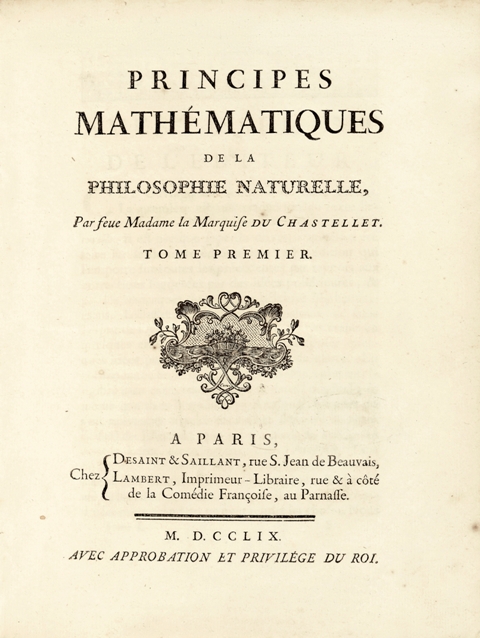Émilie du Châtelet
This page has been claimed by Taylor Poulos (tpoulos3)
Life
Émilie du Châtelet was born in Paris on December 17th, 1706. As an academically gifted child, she was able to study Latin, Italian and English, an impressive feat at time for a young girl in 18th century France. She was encouraged at an early age to pursue mathematics by a family friend, M. de Mezieres. She spent a significant amount of time working alongside Voltaire at Cirey and working with famous tutors such as Samuel Koenig. She contributed a great deal to physics and was prolific in her academic publications. In 1749 and died following the birth of her fourth child.
Influences and Companions
Émilie was familiar with, or was tutored by all of the following: Pierre Louis de Maupertuis, Alexis-Claude Clairaut, Samuel Koenig, and several members of the Bernoulli family. With her advanced capabilities in both mathematics and physics, she was able to write capably about Newton's physics.
Notable Achievements
Academic Works
She is perhaps best known for her french translation of Newton's Principia. Through this work, she contributed largely to the shift in France away from an acceptance of Cartesian physics and toward the embrace of Newtonian physics. In her own work, Du Châtelet sought a metaphysical basis for the Newtonian physics she embraced following the rejecting of Cartesianism. She died shortly after she completed this work, an it remained unpublished until 1759. To this day, her work is still the leading French translation of Newton's book.
In 1740, she published her Institutions de Physique (The Foundations of Physics), which was intended to act as a physics textbook for her son. In fact, it was a forward-thinking and original work. A second edition was published in 1742 under a new title, Institutions Physique. In this text, Émilie provided a metaphysical explanation for Newtonian physics. The work of Leibnizian and Wolffian heavily influenced this particular work. This work sparked a debate on with Jean-Jacques Dortous de Mairan.
Influence on Voltaire
Voltaire has acknowledged Émilie du Châtelet's significant contribution to his book, Eléments de la philosophie de Newton, written in 1738.
Lost Works
It used to be widely believed that there was merely one surviving chapter from an otherwise lost work written by Du Châtelet that was entitled “Essai sur l'optique”. However, more recently, three complete copies of this Essai were found. One copy was located among Bernoulli's papers in Basel and two that have been acquired recently by the Musée des Lettres et Manuscrits in Paris.
Study of Fire
In 1737, Du Châtelet (alongside Voltaire) entered a competition to explain the nature of fire, conducting her experiments in secret while Voltaire also conducted experiments for his entry to the competition. Both Du Châtelet's and Voltaire's entries focused on disproving the theory that fire is a material substance, and both of their theories were published along with the three winners (including the essay by Leonhard Euler). Du Châtelet repeatedly altered her theory on fire and made significant changed to her original essay as her thoughts on the nature of fire matured.
Non-technical Writings
Du Châtelet had a strong interest in ethics, theology and the Bible, and the source of human happiness.These are indicated by her translating of portions of Mandeville's Fable of the Bees, her book titled Examens de la Bible and her semi-autobiographical book titled Discours sur le Bonheur. Additionally, much of her non-scientific work touched on the subject of women's social roles and their education as she lived and worked in a male-dominated society.
Connectedness
- Connection to something I am interested in: Émilie du Châtelet was a woman who successfully integrated into a technical, male-dominated field. Her work is interesting as she was able to combine fields of physics, math, ethics and philosophy, which I find fascinating.
- Connection to my major: Her work involved the study of math and physics, both of which are necessary to my industrial engineering major. Additionally, her French translation of Newton's Principia is relevant to my French minor, as her work still directly impacts French society.
- Industrial application to her work:
History
Put this idea in historical context. Give the reader the Who, What, When, Where, and Why.
See also
Crater du Chatelet on Venus
Further reading
Books, Articles or other print media on this topic
External links
Internet resources on this topic
References
https://www.agnesscott.edu/lriddle/women/chatelet.htm http://plato.stanford.edu/entries/emilie-du-chatelet/ http://www-history.mcs.st-and.ac.uk/Biographies/Chatelet.html

